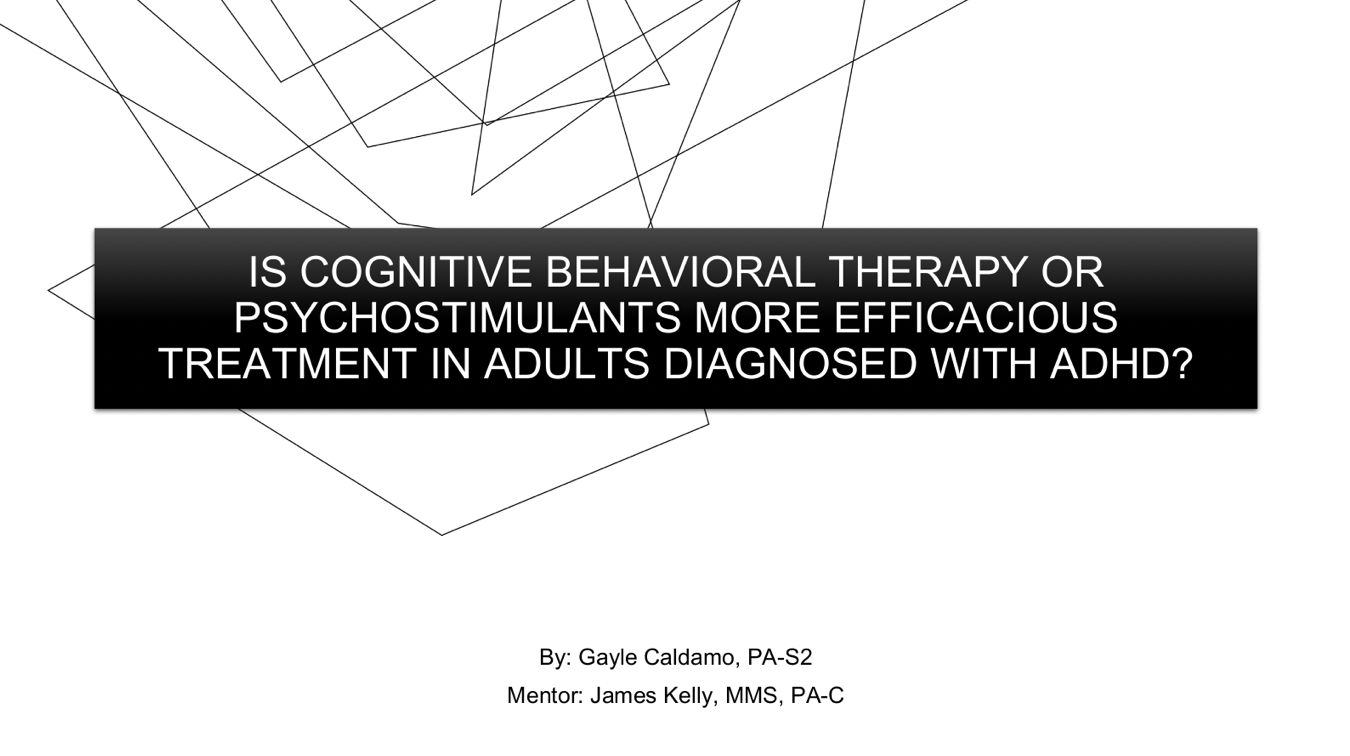 As mental health becomes a growing concern among young adults, Gayle Caldamo, MMS ‘22, saw a growing need for mental health research and widespread knowledge. So for her capstone project she decided to focus her efforts on answering the question; is cognitive behavior therapy (CBT) or psychostimulants more efficacious treatment in adults diagnosed with attention-deficit/hyperactivity disorder (ADHD)?
As mental health becomes a growing concern among young adults, Gayle Caldamo, MMS ‘22, saw a growing need for mental health research and widespread knowledge. So for her capstone project she decided to focus her efforts on answering the question; is cognitive behavior therapy (CBT) or psychostimulants more efficacious treatment in adults diagnosed with attention-deficit/hyperactivity disorder (ADHD)?
According to the United Kingdom National Health Service, CBT is a form of psychological treatment that involves efforts to change a patient’s thinking patterns when dealing with overwhelming problems by breaking them down into smaller parts, its mechanism is to directly affect the processing centers of the brain related to ADHD behaviors. The individual will be able to recognize maladaptive behaviors and relearn better coping mechanisms with CBT. CBT typically treats current concerns and stressors rather than past and is used for a variety of mental health concerns such as ADHD, bipolar disorder, obsessive-compulsive disorder, eating disorders, insomnia, etc.
“Although ADHD is childhood dominant, we have seen that it persists past childhood. Life can catch up with you and the symptoms of ADHD can manifest later in life,” said Caldamo. “I wanted to see the effectiveness of psychostimulants and CBT for ADHD treatment methods for adult populations, specifically those in graduate school, to see how it affects procrastination, organization, etc.”
On top of the stressors of life and graduate school. Caldamo also wanted to focus on the lack of coping mechanisms that many adults have when they are faced with worsening symptoms of ADHD. She described how many adults believe they have strong coping mechanisms, but once faced with a major challenge, those coping skills often don’t hold strong.
She felt a strong connection to her research as a student of the University’s Physician Assistant (PA) Studies program at the time, she saw the common stressors and symptoms that would manifest in herself and others, such as procrastination, inability to concentrate, struggles with organization, etc. She feels her research will be helpful to many college-age students or adults who are dealing with these symptoms but are unsure of which treatment plan is best.
Caldamo’s research showed that the fastest treatment for ADHD are psychostimulants. Although CBT is not the quickest treatment, CBT and psychostimulants showed very similar effectiveness for patients. In all, she concluded that both psychostimulants and CBT are reasonable treatment options as first-line monotherapy for adults with ADHD. With a safer therapeutic profile and better compliance, CBT is a long-term plan for patients whereas psychostimulants can be seen more short-term due to its association with potential adverse effects such as weight loss and exacerbation of any cardiovascular comorbidities.
Psychostimulants are also Schedule II drugs which have a high chance of being abused so a lot of precaution has to be accounted for before starting. “Through my research, I wanted to show that CBT can help with the emotional aspect of developing coping mechanisms in addition to treating the core symptoms of ADHD. Many adults are already taking a cocktail of medications and/or have plenty of comorbidities, adding an addictive medication can be a negative factor,” said Caldamo. “Many papers that I saw while conducting my research didn’t compare the two treatment methods individually, it was typically CBT and psychostimulants together, so it was a very interesting research process to take what I have researched and properly synthesize it all together.”
